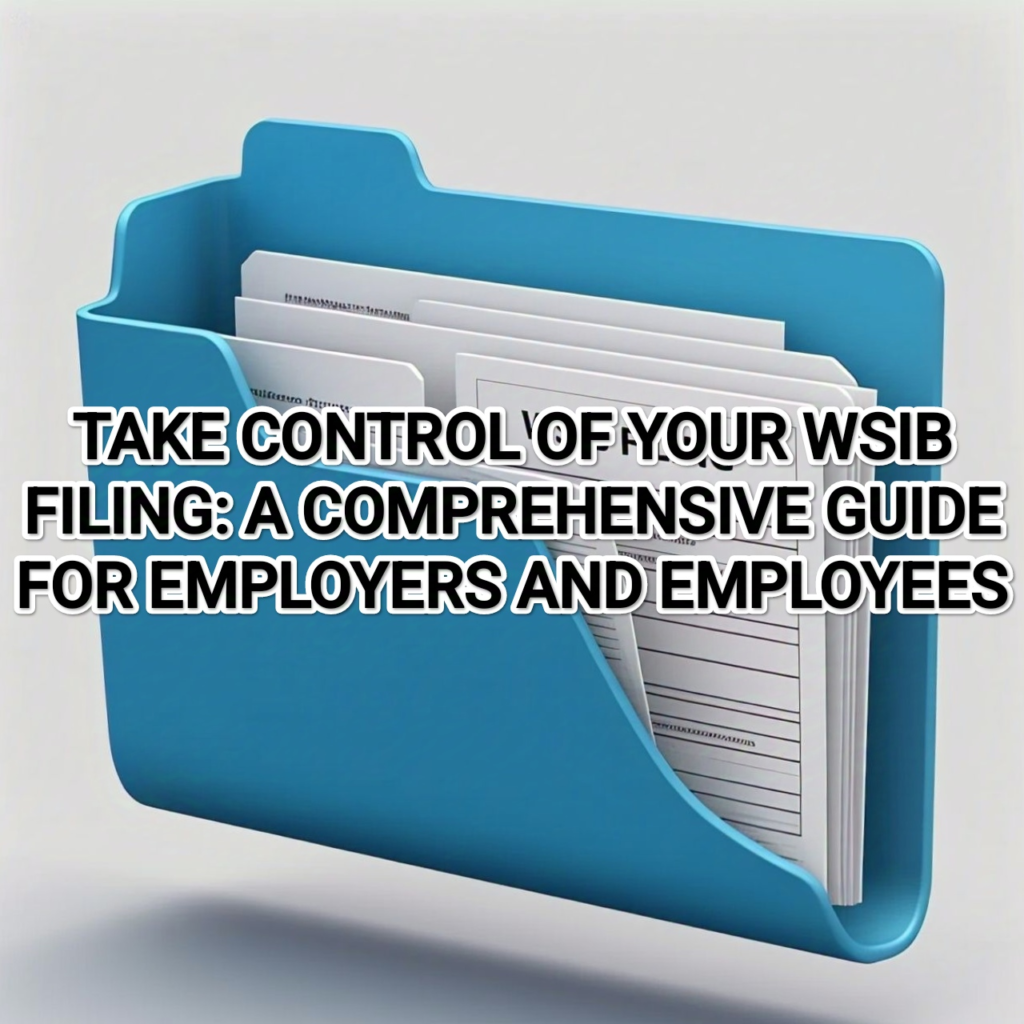TAKE CONTROL OF YOUR WSIB FILING: A COMPREHENSIVE GUIDE FOR EMPLOYERS AND EMPLOYEES
Take control of your WSIB filing with this comprehensive guide for employers and employees. As a Canada tax expert and financial advisor in Ontario, we understand the complexities of Workplace Safety and Insurance Board (WSIB) filing. Navigating the system can be daunting, especially for those unfamiliar with the process. In this guide, we will walk you through the steps to take control of your WSIB filing, addressing common pain points and offering practical solutions.
UNDERSTANDING WSIB FILING
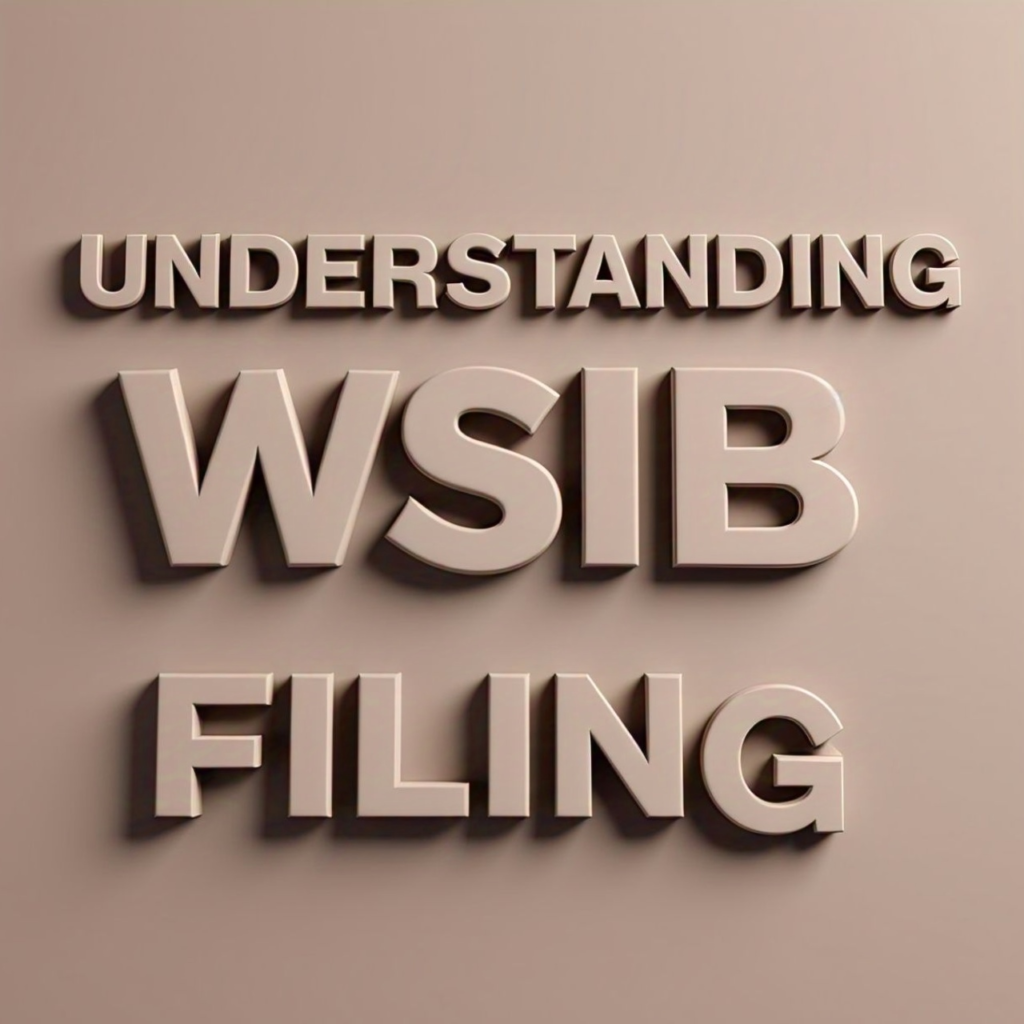
Before diving into the nitty-gritty, it’s essential to understand the purpose of WSIB filing. The Workplace Safety and Insurance Act (WSIA) requires employers to provide insurance coverage for their employees in case of work-related injuries or illnesses. WSIB filing is the process of reporting and managing these claims.
WHAT IS WSIB FILING?
WSIB filing refers to the process of reporting and managing workplace injuries and illnesses to the Workplace Safety and Insurance Board (WSIB) in Ontario, Canada.
WHO IS REQUIRED TO FILE WITH WSIB
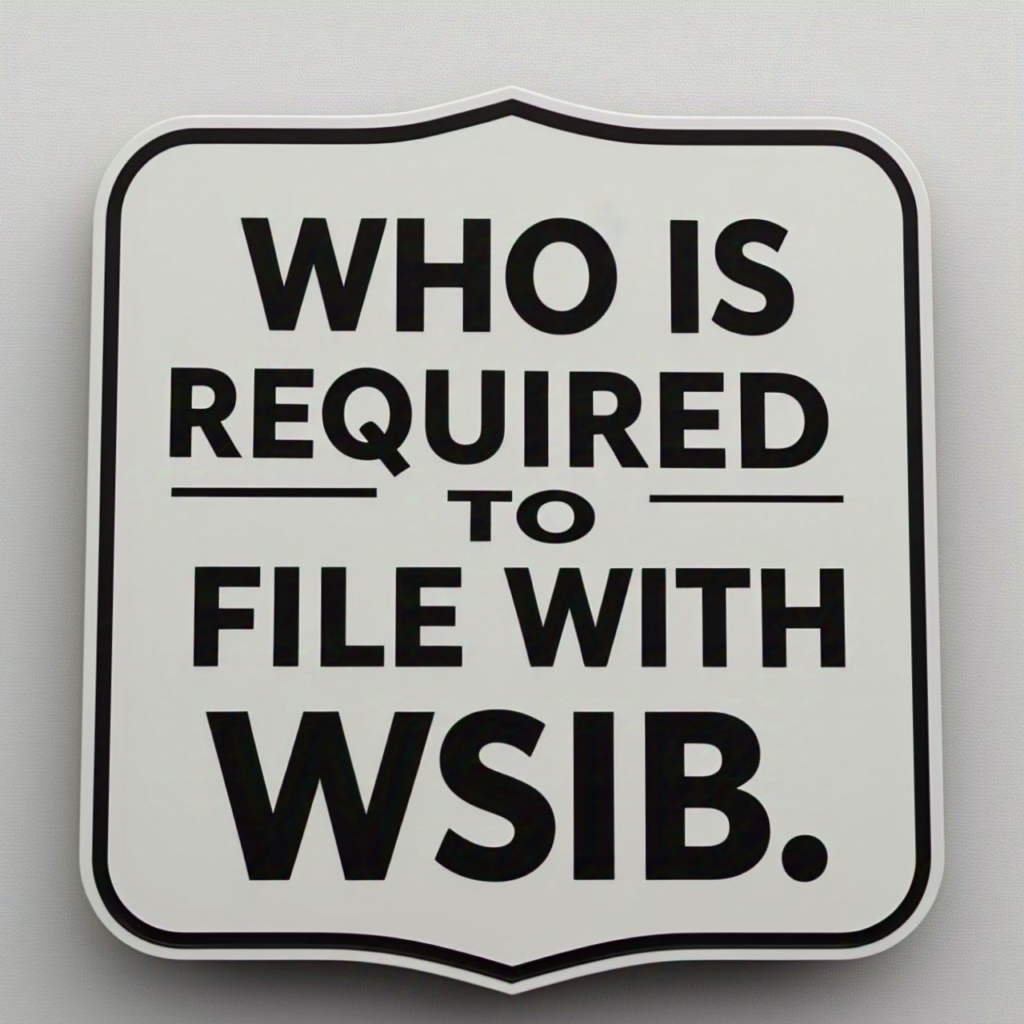
EMPLOYERS
1. Mandatory Coverage: Employers in Ontario, Canada, who have workers covered under the Workplace Safety and Insurance Act (WSIA) must file with WSIB.
2. Construction Industry: Employers in the construction industry, including contractors and subcontractors, must file with WSIB.
3. Agricultural Industry: Employers in the agricultural industry, including farmers and agricultural workers, must file with WSIB.
EMPLOYEES
1. Injured Workers: Employees who suffer a work-related injury or illness must report the incident to their employer and file a claim with WSIB.
2. Occupational Disease: Employees who contract an occupational disease must report the condition to their employer and file a claim with WSIB.
OTHER PARTIES
1. Insurance Brokers: Insurance brokers who provide workplace safety and insurance services to employers must file with WSIB on behalf of their clients.
2. Third-Party Administrators: Third-party administrators who manage workplace safety and insurance claims on behalf of employers must file with WSIB.
EXCEPTIONS
1. Exempt Industries: Certain industries, such as banking and finance, are exempt from WSIB coverage.
2. Independent Contractors: Independent contractors who are not considered employees under the WSIA may not be required to file with WSIB.
3. Federal Government Employees: Employees of the federal government are covered under the Government Employees Compensation Act (GECA) and are not required to file with WSIB.
It is essential to note that even if an employer or employee is exempt from WSIB coverage, they may still be required to file with WSIB in certain circumstances. It is always best to consult with a qualified professional or WSIB directly to determine specific filing requirements.
TYPES OF WSIB CLAIMS
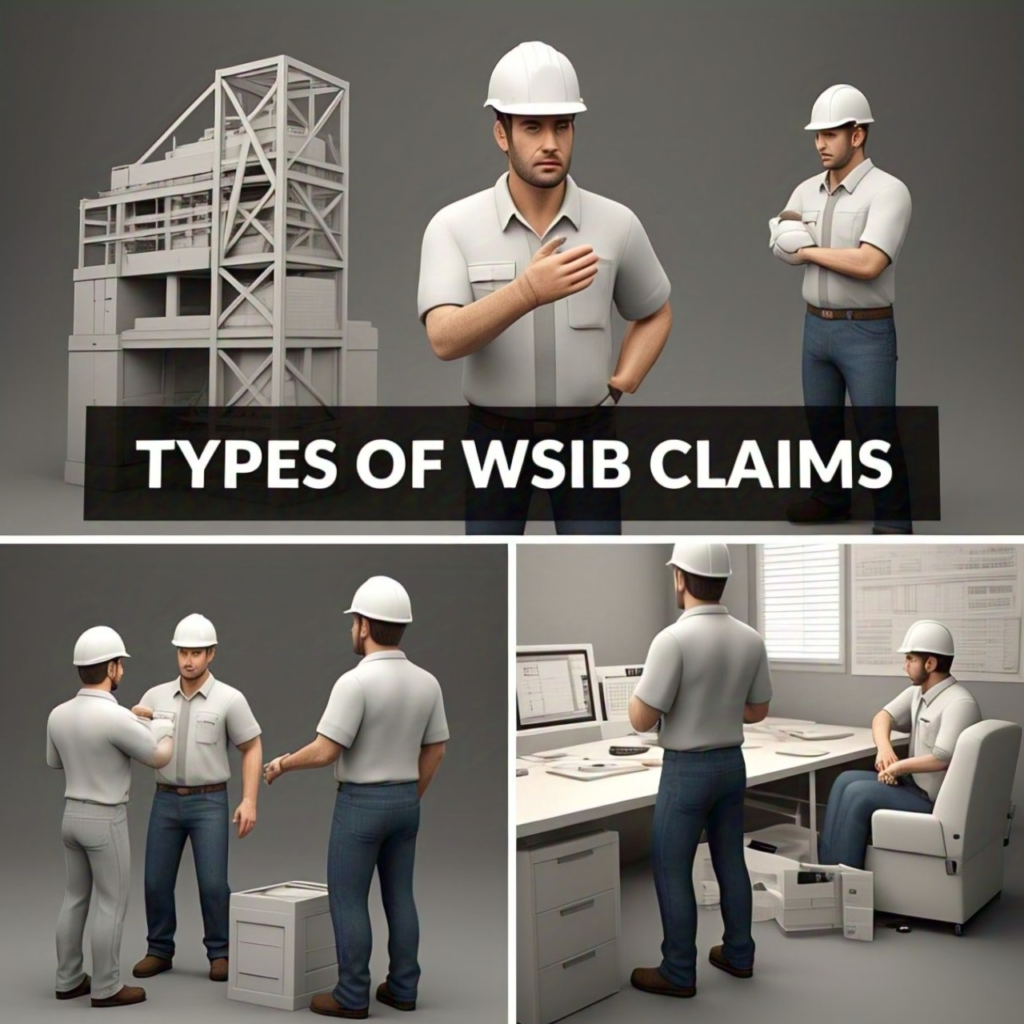
1. Work-Related Injury Claims
– Claims for injuries or illnesses that occur in the workplace or as a result of work-related activities.
– Examples: cuts, broken bones, sprains, strains, and repetitive strain injuries.
2. Occupational Disease Claims
– Claims for diseases or conditions that are caused or exacerbated by work-related factors.
– Examples: lung disease, cancer, hearing loss, and skin conditions.
3. Traumatic Mental Stress Claims
– Claims for mental stress or trauma caused by a work-related event or situation.
– Examples: post-traumatic stress disorder (PTSD), anxiety, depression, and stress-related disorders.
4. Chronic Stress Claims
– Claims for stress-related conditions that are caused or exacerbated by work-related factors.
– Examples: chronic stress, burnout, and stress-related disorders.
5. Repetitive Strain Injury (RSI) Claims
– Claims for injuries or conditions caused by repetitive movements or actions.
– Examples: carpal tunnel syndrome, tendonitis, and bursitis.
6. Noise-Induced Hearing Loss (NIHL) Claims
– Claims for hearing loss caused by exposure to loud noises in the workplace.
– Examples: permanent hearing loss, tinnitus, and hearing-related disorders.
7. Occupational Skin Disease Claims
– Claims for skin conditions caused or exacerbated by work-related factors.
– Examples: dermatitis, eczema, and skin cancer.
8. Work-Related Death Claims
– Claims for benefits and compensation in the event of a work-related death.
– Examples: fatal injuries, occupational diseases, and traumatic mental stress.
9. Loss of Earnings (LOE) Claims
– Claims for benefits and compensation for loss of earnings due to a work-related injury or illness.
10. Future Economic Loss (FEL) Claims
– Claims for benefits and compensation for future economic loss due to a work-related injury or illness.
It’s essential to note that each type of claim has its own set of eligibility criteria, documentation requirements, and benefits. Employers and employees should consult with a qualified professional or WSIB directly to determine the specific type of claim and the required documentation.
WSIB FILING PROCESS: A STEP-BY-STEP GUIDE
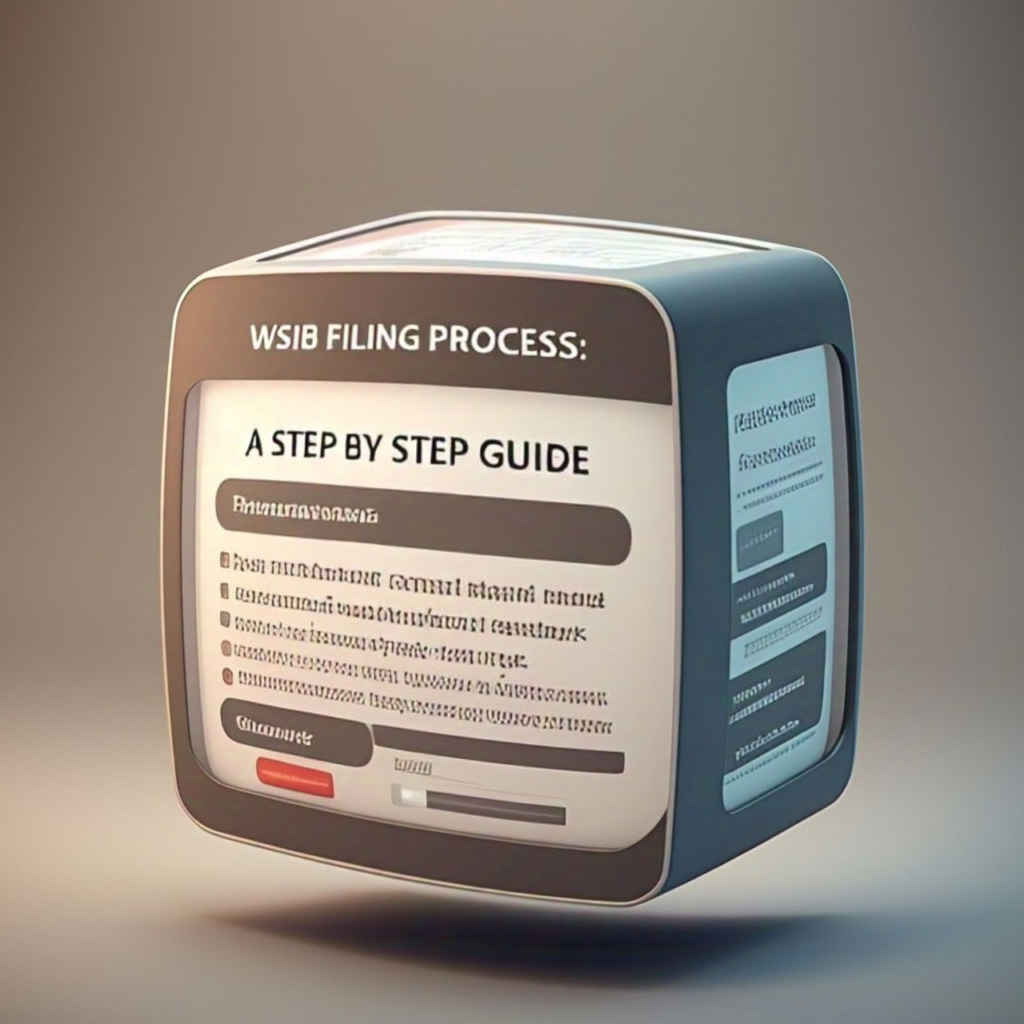
Step 1: Report the Injury or Illness
1. Immediate Reporting: The worker or employer must report the injury or illness to WSIB immediately.
2. Initial Report: The employer completes the WSIB Form 6 (Report of Occupational Injury or Disease) and submits it to WSIB.
Step 2: Complete the WSIB Form 6
1. Accurate Information: The employer must provide accurate and complete information on the WSIB Form 6.
2. Required Documentation: The employer must attach required documentation, such as medical reports and witness statements.
Step 3: Submit the WSIB Form 6
1. Timely Submission: The employer must submit the WSIB Form 6 to WSIB within three days of notification.
2. Electronic or Mail Submission: The employer can submit the form electronically or by mail.
Step 4: Provide Additional Documentation
1. Medical Reports: The employer must provide medical reports and other relevant documentation to support the claim.
2. Witness Statements: The employer must provide witness statements, if applicable.
Step 5: WSIB Review and Determination
1. WSIB Review: WSIB reviews the claim and determines eligibility for benefits.
2. Notification of Decision: WSIB notifies the worker and employer of the decision.
Step 6: Appeals and Dispute Resolution
1. Appeal Process: If the worker or employer disagrees with the WSIB decision, they can appeal the decision.
2. Dispute Resolution: WSIB provides dispute resolution services to resolve appeals.
Step 7: Ongoing Communication and Documentation
1. Regular Updates: The employer must provide regular updates on the worker’s status.
2. Ongoing Documentation: The employer must maintain accurate and complete documentation throughout the claims process.
Step 8: Return-to-Work Process
1. Return-to-Work Plan: The employer must develop a return-to-work plan for the worker.
2. Gradual Return to Work: The employer must provide a gradual return-to-work program for the worker.
Step 9: Claim Closure
1. Claim Closure: WSIB closes the claim when the worker has recovered and returned to work.
2. Final Decision: WSIB provides a final decision on the claim.
By following these steps, employers and employees can ensure a smooth and efficient WSIB filing process.
BENEFITS OF PROPER WSIB FILING
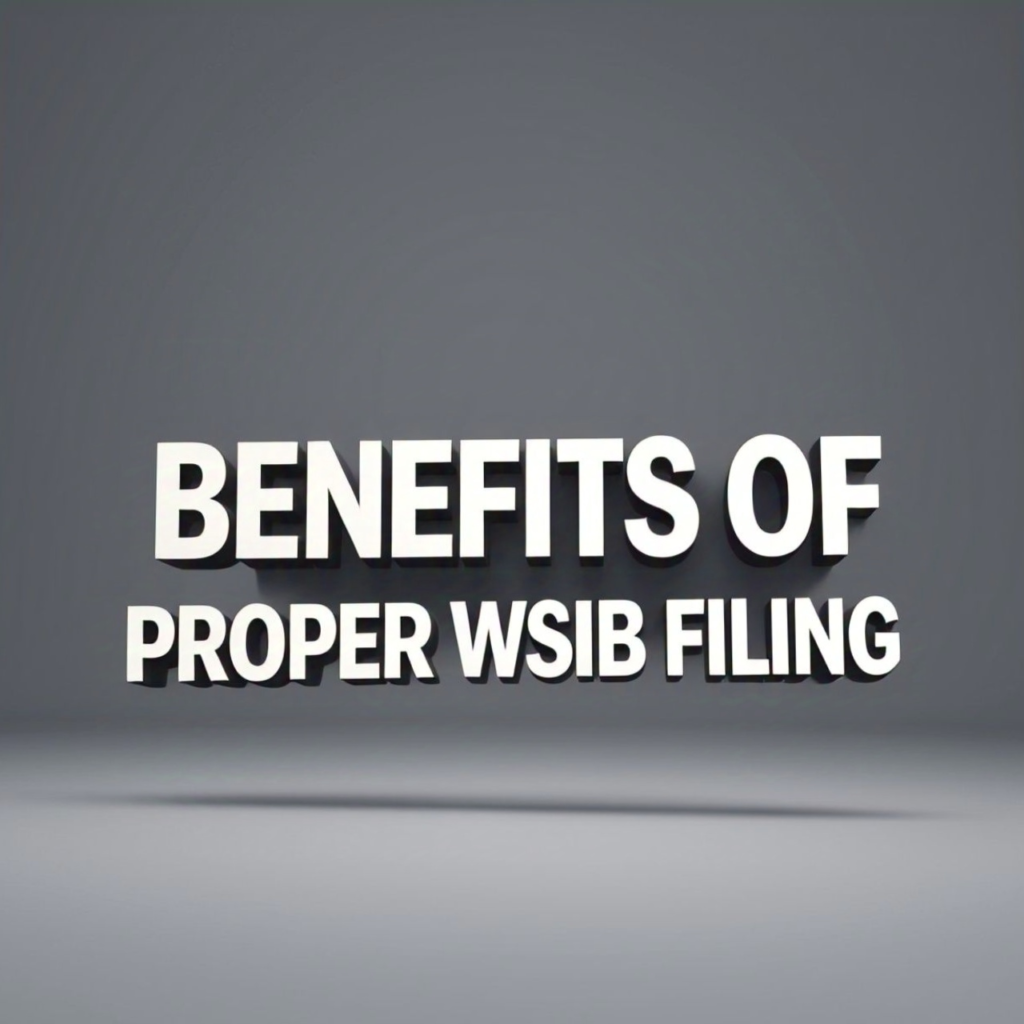
Proper WSIB filing is crucial for both employers and employees. Some benefits include:
BENEFITS FOR EMPLOYERS
1. Reduced Costs: Proper WSIB filing helps employers avoid costly penalties and fines associated with late or inaccurate reporting.
2. Improved Compliance: By following WSIB regulations, employers demonstrate their commitment to workplace safety and avoid potential audits and investigations.
3. Enhanced Reputation: Proper WSIB filing reflects positively on an employer’s reputation, showcasing their dedication to employee well-being and safety.
4. Streamlined Processes: Efficient WSIB filing processes reduce administrative burdens, freeing up staff to focus on core business activities.
5. Better Risk Management: Accurate WSIB reporting enables employers to identify and mitigate workplace hazards, reducing the likelihood of future injuries and illnesses.
BENEFITS FOR EMPLOYEES
1. Timely Benefits: Proper WSIB filing ensures employees receive benefits and compensation in a timely manner, helping them cope with work-related injuries or illnesses.
2. Fair Compensation: Accurate WSIB reporting ensures employees receive fair compensation for their injuries or illnesses, reflecting the severity of their condition.
3. Improved Health Outcomes: Proper WSIB filing facilitates access to medical treatment and rehabilitation services, promoting better health outcomes for employees.
4. Reduced Stress: Efficient WSIB filing processes minimize stress and uncertainty for employees, allowing them to focus on recovery and returning to work.
5. Increased Trust: Proper WSIB filing fosters trust between employees and employers, demonstrating a commitment to employee well-being and safety.
BENEFITS FOR BOTH EMPLOYERS AND EMPLOYEES
1. Improved Workplace Safety: Proper WSIB filing promotes a culture of workplace safety, encouraging both employers and employees to identify and mitigate hazards.
2. Reduced Litigation: Accurate WSIB reporting reduces the likelihood of disputes and litigation, promoting a more collaborative and constructive approach to resolving workplace injuries and illnesses.
3. Enhanced Communication: Proper WSIB filing facilitates open and transparent communication between employers, employees, and WSIB, ensuring all parties are informed and engaged throughout the process.
4. Increased Efficiency: Streamlined WSIB filing processes reduce administrative burdens, minimizing the time and resources required to manage workplace injuries and illnesses.
5. Better Data-Driven Decision Making: Accurate WSIB reporting provides valuable insights into workplace injuries and illnesses, enabling employers and employees to make data-driven decisions to improve workplace safety and health.
COMMON PAIN POINTS IN WSIB FILING
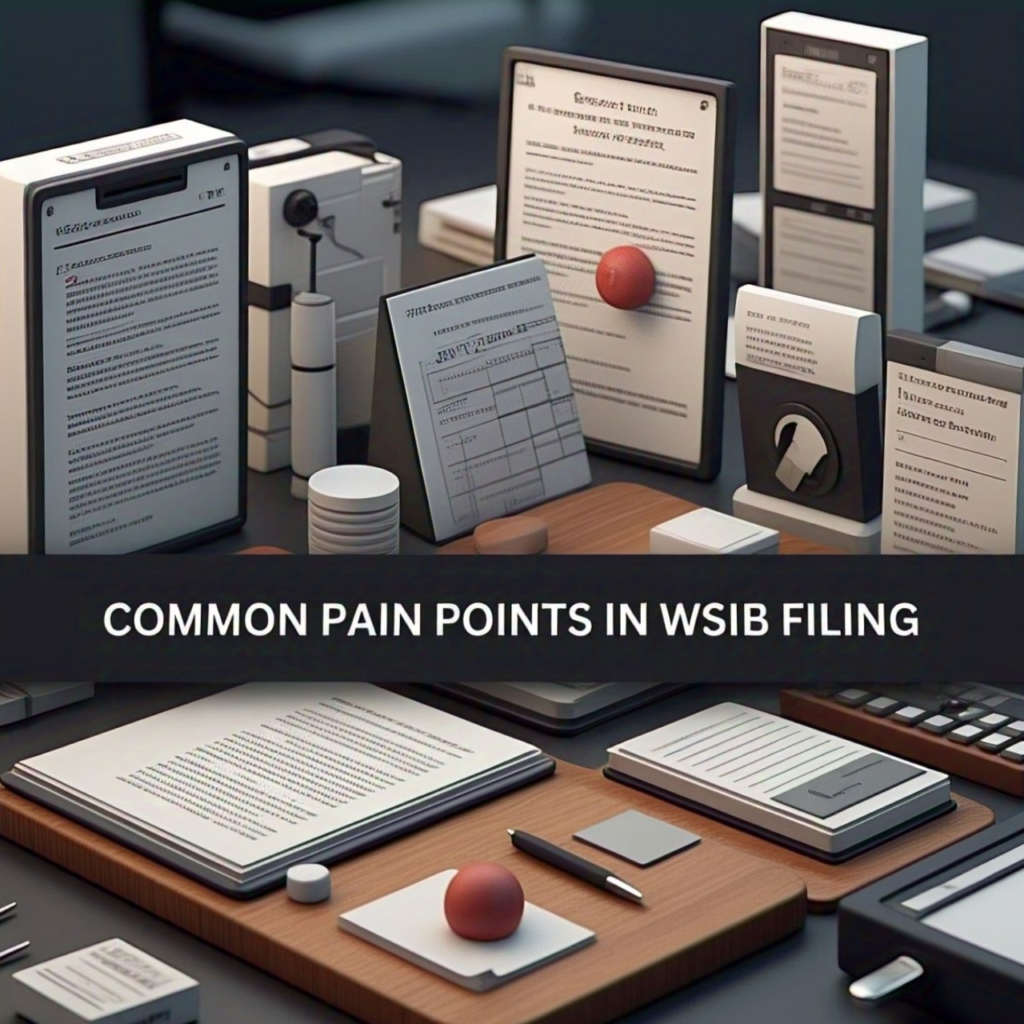
Common pain points in WSIB filing can be a challenge for both employers and employees. Here are some of the most significant ones:
1. Inaccurate or Incomplete Information
Providing incorrect or incomplete information on WSIB forms can lead to delays, disputes, or even claim denials. It’s essential to ensure that all information is accurate and complete to avoid these issues.
2. Lack of Communication
Poor communication between employers, employees, and WSIB can cause frustration and delays. Regular updates and open communication channels can help resolve issues promptly.
3. Complexity of WSIB Policies and Procedures
WSIB policies and procedures can be complex and difficult to navigate. Employers and employees may struggle to understand the requirements, leading to mistakes and delays.
4. Delays in Filing Claims
Failing to file WSIB claims promptly can result in lost benefits and compensation. Employers and employees must prioritize timely filing to avoid these consequences.
5. Disputes and Appeals
Disputes and appeals can be time-consuming and costly. Employers and employees must be prepared to provide supporting evidence and navigate the appeals process.
6. Return-to-Work Challenges
Return-to-work programs can be difficult to implement, especially if employers and employees are not on the same page. Effective communication and planning are crucial to ensure a smooth transition.
7. Fraud and Non-Compliance
Fraud and non-compliance can result in severe penalties, fines, and even prosecution. Employers and employees must be aware of the consequences of fraudulent activities and ensure compliance with WSIB regulations.
8. Chronic Pain and Mental Health Claims
Claims related to chronic pain and mental health can be complex and require specialized expertise. Employers and employees must be prepared to provide supporting medical evidence and navigate the claims process.
By understanding these common pain points, employers and employees can take proactive steps to address them and ensure a smoother WSIB filing process.
PRACTICAL SOLUTIONS FOR EMPLOYERS
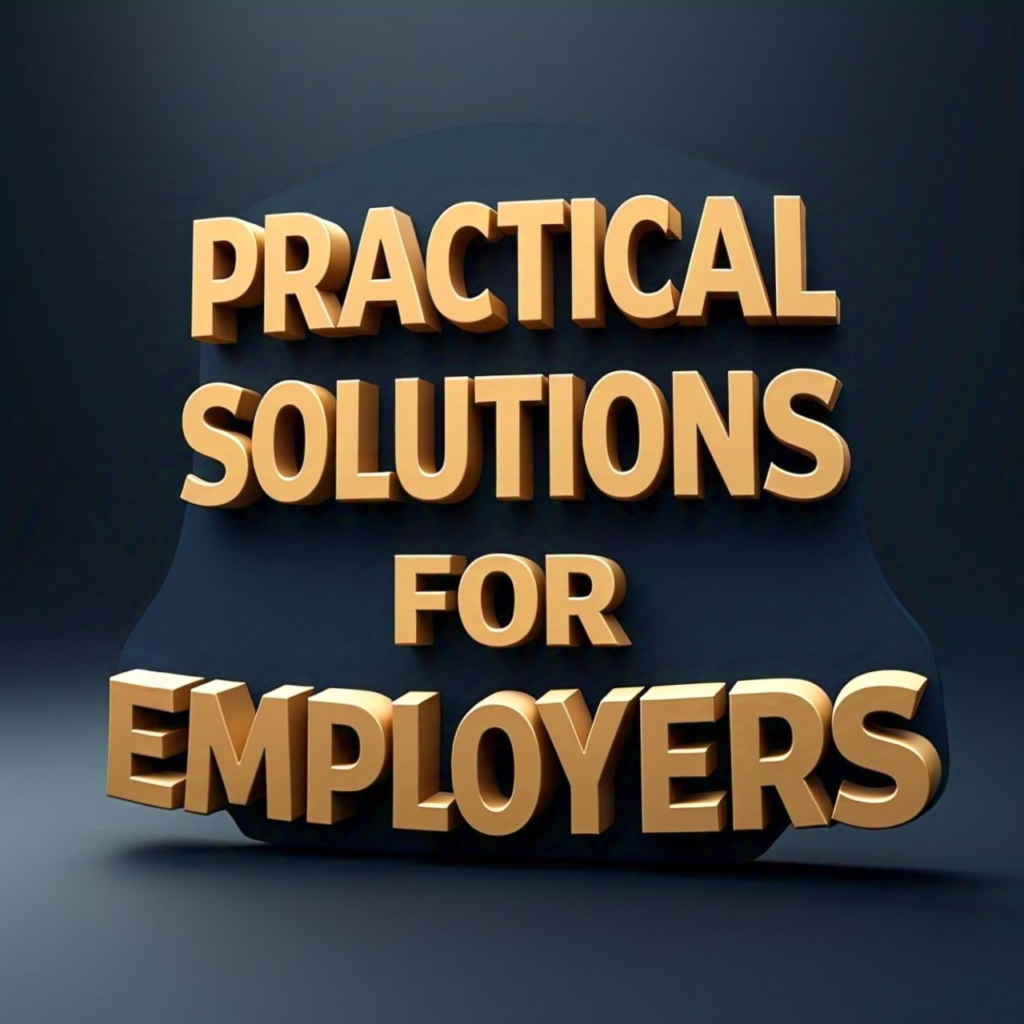
As an employer, taking control of your WSIB filing requires proactive steps:
1. Designate a WSIB Coordinator
Employers should designate a WSIB coordinator to manage WSIB-related tasks. This person will be responsible for reporting workplace injuries, completing WSIB forms, and communicating with WSIB. Having a dedicated WSIB coordinator ensures that WSIB-related tasks are completed accurately and on time.
2. Develop a WSIB Filing Process
Employers should develop a WSIB filing process that outlines the steps to be taken in the event of a workplace injury. This process should include:
– Reporting the injury to WSIB
– Completing WSIB forms
– Providing supporting documentation
– Communicating with WSIB
Having a clear WSIB filing process ensures that all necessary steps are taken, and that WSIB-related tasks are completed efficiently.
3. Provide Employee Training
Employers should provide employee training on WSIB policies and procedures. This training should cover:
– Reporting workplace injuries
– Completing WSIB forms
– Understanding WSIB benefits and eligibility
Employee training ensures that employees understand their roles and responsibilities in the WSIB filing process.
4. Maintain Accurate Records
Employers should maintain accurate and up-to-date records of workplace injuries, including:
– Injury reports
– WSIB forms
– Medical documentation
– Communication with WSIB
Accurate record-keeping ensures that employers can provide supporting documentation for WSIB claims and respond to WSIB inquiries.
5. Conduct Regular Audits
Employers should conduct regular audits of their WSIB filing process to ensure compliance with WSIB regulations. Audits should include:
– Reviewing WSIB forms for accuracy and completeness
– Verifying supporting documentation
– Ensuring timely reporting of workplace injuries
Regular audits ensure that employers identify and address any issues or discrepancies in their WSIB filing process.
6. Communicate with WSIB
Employers should communicate regularly with WSIB to ensure that WSIB-related tasks are completed efficiently. Communication should include:
– Reporting workplace injuries
– Providing supporting documentation
– Responding to WSIB inquiries
Effective communication with WSIB ensures that employers can resolve any issues or discrepancies in their WSIB filing process.
7. Implement a Return-to-Work Program
Employers should implement a return-to-work program to help injured employees return to work safely and efficiently. Return-to-work programs should include:
– Modified work duties
– Gradual return to work
– Communication with WSIB
Implementing a return-to-work program ensures that employers can reduce the risk of future injuries and minimize the impact of workplace injuries on their business.
8. Monitor WSIB Claims
Employers should monitor WSIB claims to ensure that they are being processed efficiently and accurately. Monitoring WSIB claims should include:
– Tracking the status of WSIB claims
– Verifying the accuracy of WSIB claims
– Responding to WSIB inquiries
Monitoring WSIB claims ensures that employers can identify and address any issues or discrepancies in their WSIB filing process.
9. Provide Support to Injured Employees
Employers should provide support to injured employees to help them recover and return to work safely and efficiently. Support should include:
– Modified work duties
– Access to medical treatment
– Communication with WSIB
Providing support to injured employees ensures that employers can reduce the risk of future injuries and minimize the impact of workplace injuries on their business.
10. Review and Update WSIB Policies
Employers should review and update their WSIB policies regularly to ensure compliance with WSIB regulations. Reviewing and updating WSIB policies should include:
– Reviewing WSIB forms and procedures
– Updating WSIB policies and procedures
– Communicating changes to employees
Reviewing and updating WSIB policies ensures that employers can maintain compliance with WSIB regulations and minimize the risk of WSIB-related issues.
PRACTICAL SOLUTIONS FOR EMPLOYEES
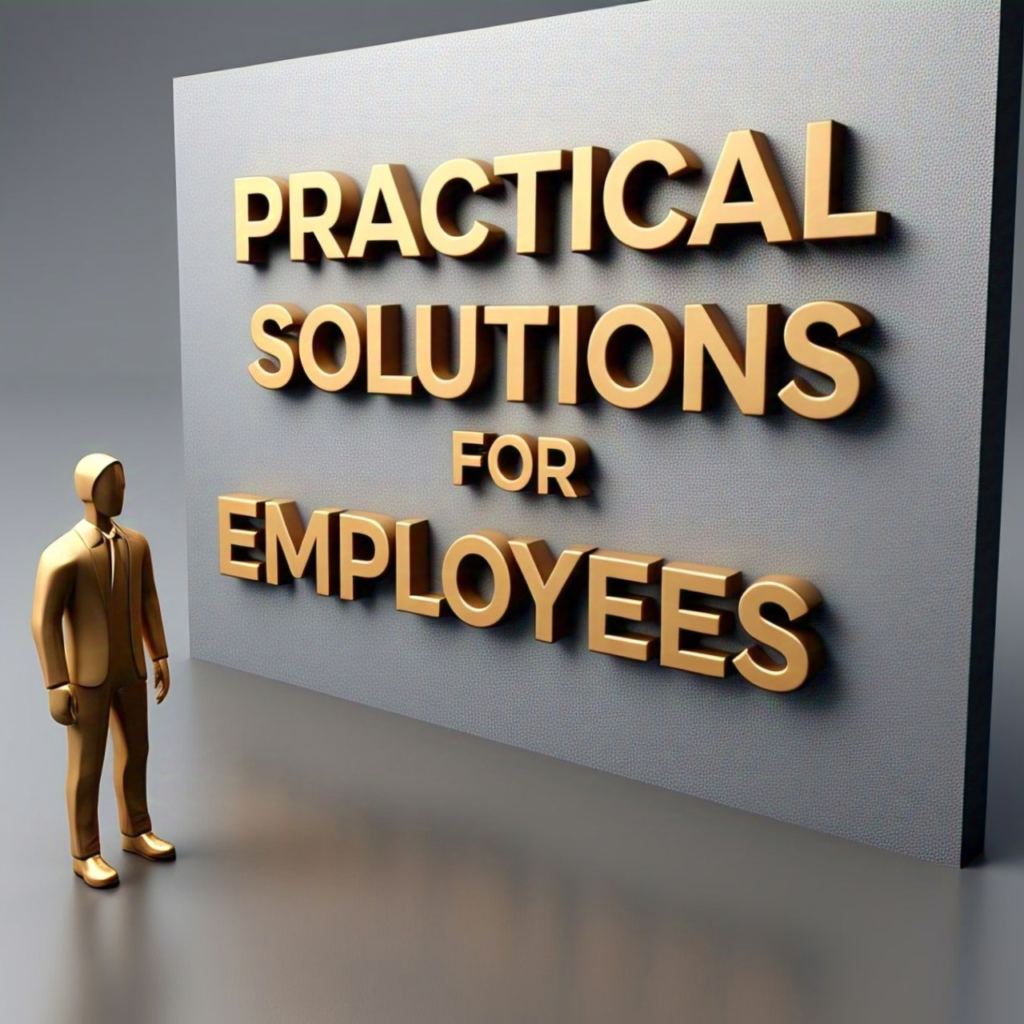
As an employee, taking control of your WSIB filing requires being proactive and informed:
1. Report Injuries Promptly
Employees should report workplace injuries or illnesses to their employer immediately. This ensures that the employer can provide medical attention and report the injury to WSIB within the required timeframe.
2. Keep Accurate Records
Employees should keep accurate records of their workplace injury or illness, including:
– Dates and times of medical appointments
– Treatment received
– Medication prescribed
– Communication with WSIB and the employer
Accurate records help employees provide supporting evidence for their claim and ensure that they receive the benefits they are entitled to.
3. Understand WSIB Benefits and Eligibility
Employees should understand their eligibility for WSIB benefits and the types of benefits available. This includes:
– Knowing the types of injuries and illnesses covered by WSIB
– Understanding the eligibility criteria for benefits
– Knowing the types of benefits available, such as wage loss benefits and medical benefits
Understanding WSIB benefits and eligibility helps employees navigate the claims process and ensure that they receive the benefits they are entitled to.
4. Communicate with WSIB
Employees should communicate regularly with WSIB to:
– Report changes in their condition
– Provide updated medical information
– Ask questions about their claim
Effective communication with WSIB ensures that employees receive the benefits they are entitled to and that their claim is processed efficiently.
5. Seek Support from a Union Representative or WSIB Advocate
Employees may want to consider seeking support from a union representative or WSIB advocate. These individuals can:
– Provide guidance on the WSIB claims process
– Help navigate disputes and appeals
– Ensure that employees receive the benefits they are entitled to
Seeking support from a union representative or WSIB advocate can help employees navigate the complex WSIB system and ensure that their rights are protected.
6. Keep Your Employer Informed
Employees should keep their employer informed about their workplace injury or illness, including:
– Providing updates on their condition
– Notifying the employer of any changes in their treatment plan
– Informing the employer of any return-to-work plans
Keeping the employer informed helps ensure that employees receive the support they need to recover from their injury or illness.
7. Understand Your Return-to-Work Options
Employees should understand their return-to-work options, including:
– Modified duties
– Gradual return-to-work plans
– Accommodations
Understanding return-to-work options helps employees navigate the return-to-work process and ensure that they are able to return to work safely and efficiently.
8. Seek Medical Attention
Employees should seek medical attention immediately if they are injured or become ill at work. This ensures that they receive the medical treatment they need to recover from their injury or illness.
9. Keep a Record of Your Medical Treatment
Employees should keep a record of their medical treatment, including:
– Dates and times of medical appointments
– Treatment received
– Medication prescribed
Keeping a record of medical treatment helps employees provide supporting evidence for their claim and ensure that they receive the benefits they are entitled to.
10. Stay Organized
Employees should stay organized throughout the WSIB claims process, including:
– Keeping track of deadlines and appointments
– Organizing medical records and documentation
– Keeping a record of communication with WSIB and the employer
Staying organized helps employees navigate the complex WSIB system and ensure that they receive the benefits they are entitled to.
THINGS TO AVOID IN WSIB FILING
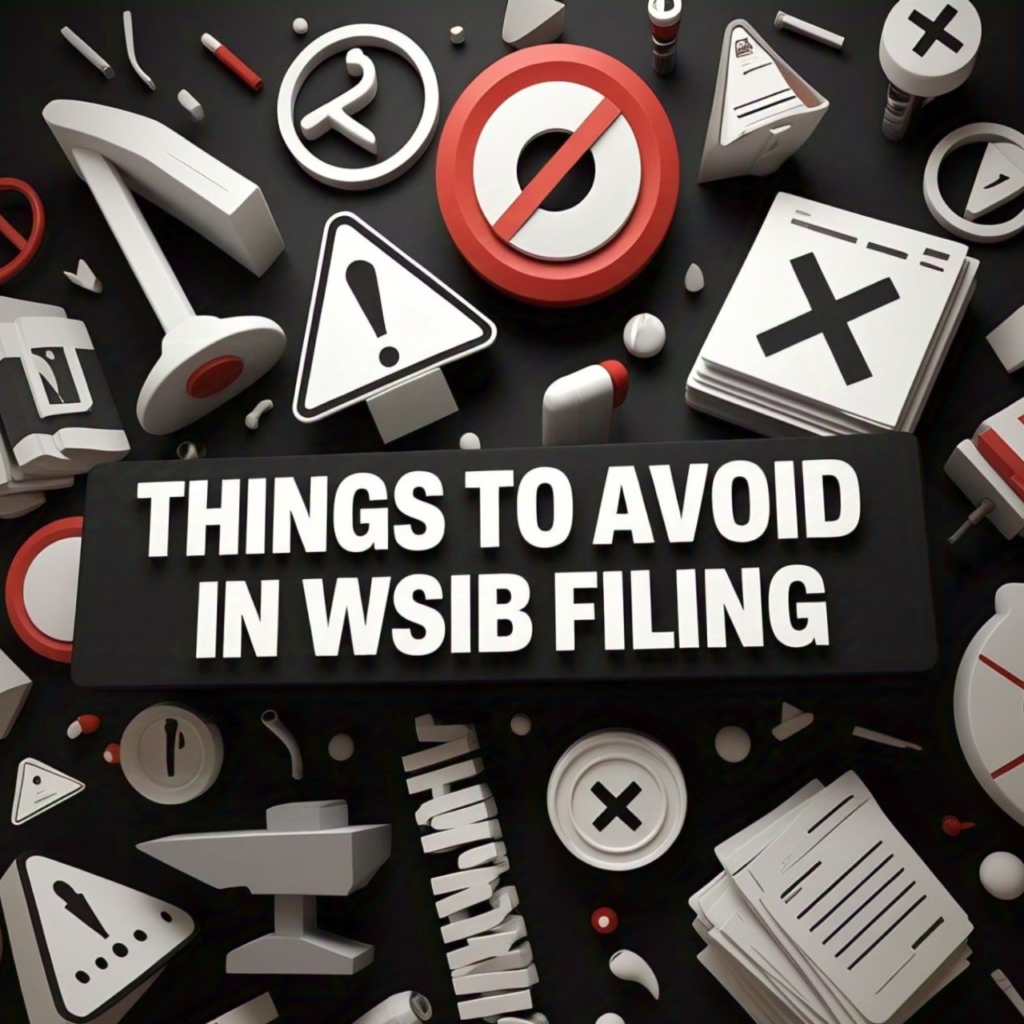
When dealing with WSIB filing, it’s essential to avoid common mistakes that can lead to delays, disputes, and increased costs:
- Delayed Reporting
Delayed reporting of workplace injuries or illnesses can lead to denied claims, reduced benefits, and even fines. Employers and employees should report injuries immediately to avoid these consequences.
- Inaccurate or Incomplete Information
Providing inaccurate or incomplete information on WSIB forms can lead to delayed or denied claims. Employers and employees should ensure that all information is accurate and complete to avoid these issues.
- Failure to Communicate
Failure to communicate with WSIB, employers, or employees can lead to misunderstandings, delayed claims, and reduced benefits. Regular communication is essential to ensure that all parties are informed and up-to-date.
- Ignoring WSIB Policies and Procedures
Ignoring WSIB policies and procedures can lead to non-compliance, fines, and even prosecution. Employers and employees should familiarize themselves with WSIB policies and procedures to avoid these consequences.
- Not Keeping Accurate Records
Not keeping accurate records of workplace injuries, illnesses, and claims can lead to delayed or denied claims, reduced benefits, and even fines. Employers and employees should maintain accurate and up-to-date records to avoid these issues.
- Not Providing Supporting Documentation
Not providing supporting documentation for WSIB claims can lead to delayed or denied claims. Employers and employees should provide all required documentation, including medical reports, witness statements, and accident reports.
- Not Following Return-to-Work Procedures
Not following return-to-work procedures can lead to delayed or denied claims, reduced benefits, and even fines. Employers and employees should follow established return-to-work procedures to ensure a safe and efficient return to work.
- Not Seeking Professional Advice
Not seeking professional advice from a qualified WSIB consultant or lawyer can lead to misunderstandings, delayed claims, and reduced benefits. Employers and employees should seek professional advice to ensure they are taking the correct steps.
- Not Staying Organized
Not staying organized throughout the WSIB claims process can lead to missed deadlines, lost documentation, and delayed claims. Employers and employees should stay organized to ensure a smooth and efficient claims process.
- Not Being Proactive
Not being proactive in managing WSIB claims can lead to delayed or denied claims, reduced benefits, and even fines. Employers and employees should be proactive in managing WSIB claims to ensure a positive outcome.
By avoiding these common mistakes, employers and employees can ensure a smooth and efficient WSIB filing process, reduce the risk of delayed or denied claims, and receive the benefits they are entitled to.
FREQUENTLY ASKED QUESTIONS
We’ve answered some frequently asked questions to provide further guidance:
Employer FAQs
1. What is WSIB and why do I need to file claims?
WSIB (Workplace Safety and Insurance Board) is a Canadian organization that provides insurance coverage for workplace injuries and illnesses. Employers must file claims to report workplace injuries and illnesses, and to provide benefits to injured workers.
2. How do I report a workplace injury or illness to WSIB?
Employers can report workplace injuries or illnesses to WSIB by completing the WSIB Form 6 (Report of Occupational Injury or Disease) and submitting it to WSIB within three days of notification.
3. What information do I need to provide to WSIB?
Employers must provide accurate and complete information, including the worker’s name, date of birth, social insurance number, and details of the injury or illness.
4. How long do I have to file a WSIB claim?
Employers must file WSIB claims within three days of notification of a workplace injury or illness.
5. Can I appeal a WSIB decision?
Yes, employers can appeal a WSIB decision if they disagree with the outcome. Appeals must be submitted in writing within 30 days of the decision.
Employee FAQs
1. What should I do if I’m injured at work?
If you’re injured at work, report the injury to your employer immediately. Your employer will provide medical attention and report the injury to WSIB.
2. How do I file a WSIB claim?
Employees do not need to file a WSIB claim directly. Employers are responsible for reporting workplace injuries and illnesses to WSIB.
3. What benefits am I eligible for under WSIB?
WSIB provides various benefits, including wage loss benefits, medical benefits, and return-to-work benefits. Eligibility for benefits depends on the nature and severity of the injury or illness.
4. How long do I have to wait for WSIB benefits?
WSIB benefits are typically paid within 10-14 days of the initial report of injury or illness.
5. Can I appeal a WSIB decision?
Yes, employees can appeal a WSIB decision if they disagree with the outcome. Appeals must be submitted in writing within 30 days of the decision.
General FAQs
1. What is the deadline for filing a WSIB claim?
The deadline for filing a WSIB claim is within three days of notification of a workplace injury or illness.
2. Can I file a WSIB claim online?
Yes, employers and employees can file WSIB claims online through the WSIB website.
3. How do I contact WSIB?
WSIB can be contacted by phone, email, or mail. Contact information is available on the WSIB website.
4. What is the WSIB appeals process?
The WSIB appeals process involves submitting a written appeal within 30 days of the decision. Appeals are reviewed by a WSIB appeals officer, and a decision is made within 30 days.
5. Can I get help with my WSIB claim?
Yes, employers and employees can get help with their WSIB claim from a qualified WSIB consultant or lawyer.
CONCLUSION
In conclusion, taking control of your WSIB filing is crucial for both employers and employees. By understanding the WSIB filing process, benefits, and requirements, employers can ensure compliance, reduce costs, and improve employee outcomes. Employees, on the other hand, can ensure they receive the benefits they are entitled to and navigate the claims process efficiently.
Key takeaways from this guide include:
– Understanding WSIB policies and procedures
– Designating a WSIB coordinator
– Maintaining accurate records
– Providing supporting documentation
– Communicating effectively with WSIB
– Seeking professional advice when needed
– Being proactive in managing WSIB claims
By following these best practices and avoiding common mistakes, employers and employees can ensure a smooth and efficient WSIB filing process.
Remember, WSIB filing is a complex process, and it’s essential to stay informed and up-to-date on the latest regulations and requirements. By taking control of your WSIB filing, you can minimize the risk of delayed or denied claims, reduce costs, and improve employee outcomes.
In summary, this guide has provided a comprehensive overview of the WSIB filing process, benefits, and requirements. By following the practical solutions and best practices outlined in this guide, employers and employees can take control of their WSIB filing and ensure a positive outcome.
CALL TO ACTION
Take Control of Your WSIB Filing Today!
Don’t let WSIB filing complexities hold you back. Take the first step towards streamlining your WSIB filing process and ensuring compliance with WSIB regulations.
For Employers:
1. Designate a WSIB coordinator to manage your WSIB filing process.
2. Develop a clear and concise WSIB filing process.
3. Provide employee training on WSIB policies and procedures.
4. Maintain accurate records and provide supporting documentation.
5. Communicate effectively with WSIB and seek professional advice when needed.
For Employees:
1. Report workplace injuries or illnesses to your employer immediately.
2. Keep accurate records of your workplace injury or illness.
3. Understand your WSIB benefits and eligibility.
4. Communicate with WSIB and your employer regularly.
5. Seek support from a union representative or WSIB advocate if needed.
Contact Us:
For personalized guidance and support, contact us today:
Phone: (647)643-1095
Email: sjohn@glhaccounting.ca
Website: https://glhaccounting.ca/blog/
Take control of your WSIB filing today and ensure a smooth and efficient process for all parties involved!
ABOUT AUTHOR
Shanel John is a dedicated Certified Public Accountant (CPA) at G.L.H. Accounting, specializing in Income Tax with 10 years of experience. Based in Brampton, Ontario, Canada, Shanel offers expertise in tax preparation, financial accounting, and advisory services. A certified QBO Pro Advisor, Shanel’s decade-long experience and knowledge make her a trusted figure in the accounting field.
ADDITIONAL RESOURCES
Canada Revenue Agency: https://www.canada.ca/en/revenue-agency/news/2023/06/the-canada-revenue-agency-and-the-workplace-safety-and-insurance-board-partner-to-give-ontario-businesses-another-way-to-pay-their-wsib-premiums.html
WSIB Ontario:
https://www.wsib.ca/en/operational-policy-manual/chronic-pain-disability

